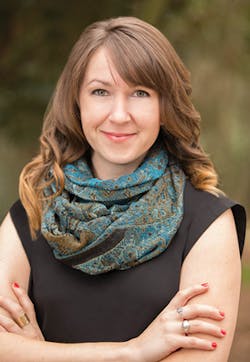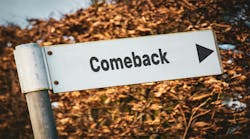EMILY VAUGHN deepens the horticultural lighting discussion to explore the role that UV LEDs can play after an LEDs Magazine webcast, as CARRIE MEADOWS reports.
Horticultural lighting based on LED technology is bolstering the solid-state lighting (SSL) market due to its ability to maximize crop yields, whether the light is produced in the visible or ultraviolet (UV) spectrum. Our colleagues at the analyst firm Strategies Unlimited have forecasted that the horticultural lighting market will grow more than 180% in the next five years, with LEDs comprising the majority of this growth. In a webcast held earlier this year, our speakers drove home once again the point that leveraging SSL in growing operations is simply good business sense: LED-based horticultural lighting delivers cost and energy savings, as we know; is manufactured with less-toxic components than other light sources; and operates with longer lifetimes. But beyond the cost and environmental values, other unique properties have come to light.
Earlier this year, Emily Vaughn, solutions manager of smart illumination and indoor agriculture technology at the DNA Group, presented a particularly intriguing picture of UV LED technology in the indoor farming application during a joint webcast with CSA Group's KC Fletcher. We've seen UV LEDs applied across a range of operations from industrial curing operations to counterfeit prevention, and they have made strides in health and hygiene applications from water disinfection to surface sanitization. But we are just beginning to hear buzz about the non-visible light source being applied to plant growth.
Vaughn summarized the features of UV LEDs that can be delivered into horticultural lighting products, such as elimination of pathogens and other organisms — not only affecting the lifecycle of growing plants but the fruits of farmers' labors after harvest, as UV irradiation has been shown to extend produce shelf life up to two times longer.
But the advantages of tailored UV light for specific plants don't stop there. Vaughn described UV as "the missing piece of the horticultural lighting puzzle" for its ability to provide stresses to the plants, which induce a favorable response — making more protective antioxidants to ward off disease as well as enhance the flavor, texture, and color of harvested produce. For example, various properties of cannabis can be affected by the appropriate application of UV light as a stressor, such as THC and terpene levels that deliver stronger plants with more medicinal value; or strawberries can be grown to be more vibrant in color and taste can be intensified as a result of the plant's natural chemistry changes.
Vaughn also addressed the misconception that sunlight is perfectly adequate to deliver enough UV light to indoor growing operations. "Greenhouse glass [and plastic] surfaces filter out almost 100%" of UV rays, Vaughn stated during the broadcast.
UV LED technology could be the next level of customization for an application as specific as horticultural lighting — a way to differentiate SSL products and appeal to growers who are looking to maximize and compete in certain crops. Read on for additional questions webcast attendees had for Vaughn and get the full webcast presentation online.
Q: If ultraviolet light doesn't go through most materials like plastic, what is a substitute material you can use?
Vaughn: The best solution by far is quartz glass. There are a few other options out there that provide less transmission, which may be acceptable for some applications, but as of today, there is nothing on the market that beats quartz. We continuously monitor the materials landscape to see if anyone has developed anything new at the price point of quartz, and hope that something new is developed in the not-too-distant future. Anyone with information is always welcome to reach out to us.
Q: The growers that I am working with continue to make statements that LED lights do not work for flowering. Are there any new developments that correct that problem?
Vaughn: All LED lights are not created equal. When growers get negative results from LED lights, we find that they may have picked the cheapest but not the most scientifically favored options. Other considerations are that an indoor growing facility is an entire ecosystem, so changing one variable changes all of the rest. To convert grow rooms from traditional lights to LEDs may require adjusting other parameters such as humidity, temperature, HVAC, and even nutrient levels. If you have shopped carefully, be prepared for things to seem a bit different at first. Follow the manufacturer's guidelines and be patient. [Editor's note: LEDs Magazine also recently published an article on horticultural lighting specification and buying considerations.]
Q: Can you give application guidelines for UV LED, especially on cannabis?
Vaughn: Several people are asking for guidelines, especially on cannabis. The answer is fairly nuanced and the research is also still being done. There are some general best practices in terms of the dose needed to trigger the UVR8 photoreceptor: strains that are more or less responsive, number of hours of exposure in a day, and when in the lifecycle to apply the light. More research needs to be done to ensure that these guidelines are absolutely optimized. The trouble is that any institution receiving federal funding is legally prohibited from studying cannabis. The real pioneers in the research here are the growers themselves, and we love partnering with medium-to-large-scale growers to collect more data!
Q: Besides cannabis, what benefits are there of UV-B to vegetables, herbs, and lettuce?
Vaughn: Edible plants have the same photoreceptor as cannabis. Nutrients like antioxidants and flavonoids (the things that make plants look, smell, and taste good) become more prevalent with UV-B exposure. There is also some interesting research showing benefits of UV-B post-harvest in extending the shelf life of produce and eradicating powdery mildew.
LEARN MORE
Horticultural lighting continues to grow into its role
We've stated multiple times that the market for horticultural lighting is expanding as SSL technology continues to gain acceptance by growers of all sizes. Yet we don't assume we know it all when it comes to such a specialized niche, which is bringing forth new opportunities all the time. Check out the article by Maury Wright from this issue, for example. Wright reported on a specialty grocer that planted its feet firmly into onsite growing operations, establishing a container farm equipped with LED lighting that allows consumers access to super-fresh produce such as herbs, lettuce, and other greens. New projects and installations such as these container farms would not be possible without the right mix of science, ingenuity, and collaboration. You will find all of the above on the menu at our second US Horticultural Lighting Conference in Denver, CO this October. Learn more about the program and register at horticulturelightingconference.com/usa/.






